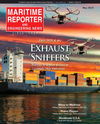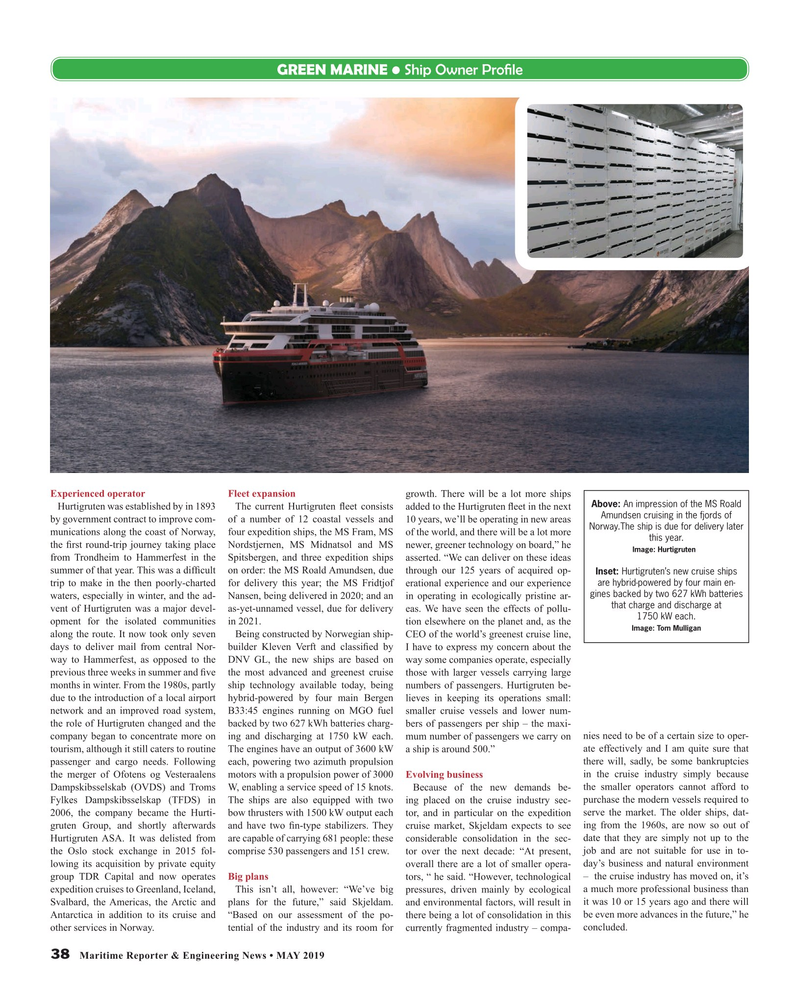
Page 38: of Maritime Reporter Magazine (May 2019)
Propulsion Annual - Green Marine Tech
Read this page in Pdf, Flash or Html5 edition of May 2019 Maritime Reporter Magazine
GREEN MARINE • Ship Owner Pro? le
Experienced operator Fleet expansion growth. There will be a lot more ships
Above: An impression of the MS Roald
Hurtigruten was established by in 1893 The current Hurtigruten ? eet consists added to the Hurtigruten ? eet in the next
Amundsen cruising in the fjords of by government contract to improve com- of a number of 12 coastal vessels and 10 years, we’ll be operating in new areas
Norway.The ship is due for delivery later munications along the coast of Norway, four expedition ships, the MS Fram, MS of the world, and there will be a lot more this year.
the ? rst round-trip journey taking place Nordstjernen, MS Midnatsol and MS newer, greener technology on board,” he
Image: Hurtigruten from Trondheim to Hammerfest in the Spitsbergen, and three expedition ships asserted. “We can deliver on these ideas summer of that year. This was a dif? cult on order: the MS Roald Amundsen, due through our 125 years of acquired op-
Inset: Hurtigruten’s new cruise ships are hybrid-powered by four main en- trip to make in the then poorly-charted for delivery this year; the MS Fridtjof erational experience and our experience gines backed by two 627 kWh batteries waters, especially in winter, and the ad- Nansen, being delivered in 2020; and an in operating in ecologically pristine ar- that charge and discharge at vent of Hurtigruten was a major devel- as-yet-unnamed vessel, due for delivery eas. We have seen the effects of pollu- 1750 kW each. opment for the isolated communities in 2021. tion elsewhere on the planet and, as the
Image: Tom Mulligan along the route. It now took only seven Being constructed by Norwegian ship- CEO of the world’s greenest cruise line, days to deliver mail from central Nor- builder Kleven Verft and classi? ed by I have to express my concern about the way to Hammerfest, as opposed to the DNV GL, the new ships are based on way some companies operate, especially previous three weeks in summer and ? ve the most advanced and greenest cruise those with larger vessels carrying large months in winter. From the 1980s, partly ship technology available today, being numbers of passengers. Hurtigruten be- due to the introduction of a local airport hybrid-powered by four main Bergen lieves in keeping its operations small: network and an improved road system, B33:45 engines running on MGO fuel smaller cruise vessels and lower num- the role of Hurtigruten changed and the backed by two 627 kWh batteries charg- bers of passengers per ship – the maxi- company began to concentrate more on ing and discharging at 1750 kW each. mum number of passengers we carry on nies need to be of a certain size to oper- tourism, although it still caters to routine The engines have an output of 3600 kW a ship is around 500.” ate effectively and I am quite sure that passenger and cargo needs. Following each, powering two azimuth propulsion there will, sadly, be some bankruptcies the merger of Ofotens og Vesteraalens motors with a propulsion power of 3000 Evolving business in the cruise industry simply because
Dampskibsselskab (OVDS) and Troms W, enabling a service speed of 15 knots. Because of the new demands be- the smaller operators cannot afford to
Fylkes Dampskibsselskap (TFDS) in The ships are also equipped with two ing placed on the cruise industry sec- purchase the modern vessels required to 2006, the company became the Hurti- bow thrusters with 1500 kW output each tor, and in particular on the expedition serve the market. The older ships, dat- gruten Group, and shortly afterwards and have two ? n-type stabilizers. They cruise market, Skjeldam expects to see ing from the 1960s, are now so out of
Hurtigruten ASA. It was delisted from are capable of carrying 681 people: these considerable consolidation in the sec- date that they are simply not up to the the Oslo stock exchange in 2015 fol- comprise 530 passengers and 151 crew. tor over the next decade: “At present, job and are not suitable for use in to- lowing its acquisition by private equity overall there are a lot of smaller opera- day’s business and natural environment group TDR Capital and now operates Big plans tors, “ he said. “However, technological – the cruise industry has moved on, it’s expedition cruises to Greenland, Iceland, This isn’t all, however: “We’ve big pressures, driven mainly by ecological a much more professional business than
Svalbard, the Americas, the Arctic and plans for the future,” said Skjeldam. and environmental factors, will result in it was 10 or 15 years ago and there will
Antarctica in addition to its cruise and “Based on our assessment of the po- there being a lot of consolidation in this be even more advances in the future,” he other services in Norway. tential of the industry and its room for currently fragmented industry – compa- concluded.
38 Maritime Reporter & Engineering News • MAY 2019
MR #5 (34-41).indd 38 5/2/2019 3:04:04 PM

 37
37

 39
39
